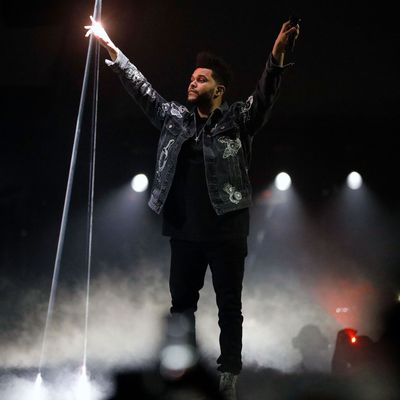
One reason to count your blessings is to make sure you actually have them. Fittingly enough for an album released on the night of Thanksgiving ÔÇö American, not Canadian ÔÇö the motivating force behind the WeekndÔÇÖs Starboy (2016) was a desire to confirm that the artist (born Abel Tesfaye) did, in fact, possess the fame he had set out to attain upon signing to a major label. One would have thought that 2014ÔÇÖs hit-studded Beauty Behind the Madness would already have proven it beyond a doubt, but perhaps the underwhelming reception to his first Republic album, Kiss Land, had left the artist wary that the secondÔÇÖs triumph had only been a fluke. Loaded with 18 tracks engineered to a standard of rigid pop precision, Starboy was designed to banish doubts of failure once and for all. It was a victory lap that doubled as insurance he had really gone the distance. If fame was lightning, lightning struck him twice: The album dominated every chart on which it appeared.
Since performing at the Grammys in February, the Weeknd has set out on a tour backing the album (Starboy: Legend of the Fall), expanding the circuit of the victory lap until it spans the globe. Double-tapping Barclays Center on consecutive nights seemed redundant, but also, in a way, necessary. Perhaps the question now wasnÔÇÖt whether he was a star, but how big a star he could become; not whether he was winning, but if he, or his fans, would get tired of all the winning. (If popular music were a video game, he was definitely going for all the achievements.)
Judging from his performance last night, it was clear that the Weeknd and his fans still have energy to spare. Thorough and brisk, TesfayeÔÇÖs 90-minute set went off without a hitch, the artist striding up and down a narrow central catwalk bisecting the pit; a four-man rock band provided accompaniment on the wide stage at the rear. The manta rayÔÇôlike stage configuration was mirrored above by an aerial installation reprising the retro sci-fi aesthetic of the tour art, the music video for Starboy closer ÔÇ£I Feel It Coming,ÔÇØ and Daft Punk, which produced ÔÇ£I Feel It Coming.ÔÇØ A large module of triangular panels were arrayed in forms resembling, successively, an Imperial Star Destroyer and Romulan warbird. Whatever its shape, the ÔÇ£spaceshipÔÇØ sent down a beaming spotlight that tracked the artistÔÇÖs motions and revealed the details of his attire: As always, Tesfaye was dressed in clothes that split the difference between fatigues and designer.
A slim majority of (lovely) songs deviated from the last two Weeknd albums. Fans hoping for more songs from the artistÔÇÖs underground mixtape days had to content themselves with a rendition of the gorgeous, aching classic ÔÇ£Wicked Games.ÔÇØ A large minority of songs consisted of TesfayeÔÇÖs featured verses for other artists ÔÇö to quote the title of a Starboy highlight, they served as reminders of his versatility, underlining his ability to take over songs regardless of the lead artist. Hits from XO vassals and guest performers Belly (ÔÇ£Might NotÔÇØ) and Nav (ÔÇ£Some WayÔÇØ), and cuts from peers like Ty Dolla $ign (ÔÇ£Or NahÔÇØ), Future (ÔÇ£Low LifeÔÇØ), and Drake (ÔÇ£Crew LoveÔÇØ) all implicitly posed a question of ownership: If Tesfaye sings the hook and matches the lead artist verse for verse, whose song is it really, by majority rules? (ÔÇ£Crew LoveÔÇØ is an especially interesting case: The song originally belonged to the Weeknd before Drake lifted it for himself.) TesfayeÔÇÖs capacity for switch-hitting has made him universally compatible; the special appearances by Juelz Santana (doing the damn ÔÇ£Dipset AnthemÔÇØ!!), Rae Sremmurd (ÔÇ£Black BeatlesÔÇØ) and French Montana ("UnforgettableÔÇØ) further testified to the range of his influence. No one occupies a more central position in contemporary pop.
Tesfaye first emerged as a singer focused on dark seduction and shadowy isolation, and though his newer work frames this aspect of him differently, it hasnÔÇÖt fully abolished it either. What the concert settings makes apparent, though, is how his recent collections, compensating for a slight drop in complexity, open up the possibility for a drastic gain in power: Power scaled to an arenaÔÇÖs space, with the band and venue sound team ensuring that the songs, physically if not spiritually, felt closer to you than your own voice. It was the sort of intimacy that only an audience of tens of thousands of bodies could generate.
For dedicated fans ÔÇö and why would you go if you werenÔÇÖt already one? ÔÇö the show was a thorough delight; if madness was in short supply, there was still plenty of beauty to go around. Still, hereÔÇÖs hoping that Tesfaye, now that heÔÇÖs confirmed his stature many times over, doesnÔÇÖt feel the need to repeat himself again. IÔÇÖm not one of those purists who plugs the early, underground work to the exclusion of everything that followed. As the shows at Barclays and elsewhere demonstrate, industry maximalism has charms all its own, and besides, the early work already testifies to the same craving for fame that the later work gratifies. Still, I do think that a turn toward weirder, leaner, riskier sounds ÔÇö neither old nor recent, but genuinely unprecedented ÔÇö might be the right step for Tesfaye to take next. Now that the mass audience chases him instead of the other way around, thereÔÇÖs never been a better time to lead them somewhere new.

